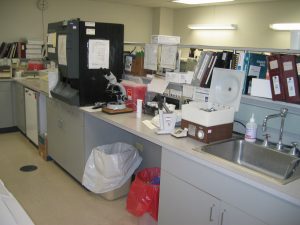 The Quality Control Laboratory in the Pharmaceutical plants plays the critical role to maintain, monitor and consistent product of Pharmaceutical products. In the laboratory from starting material to finished products being tested at the different manufacturing stages. Good Laboratory Practices assist to perform the timely and accurate analytical results. In the day to day activities in pharmaceutical quality control laboratories, The good working bench practices make big differences into error free analytical results as well as laboratory productivity. Following are some Good Practices in Pharmaceuticals Laboratory at Working Bench.. (but not limited to..)
The Quality Control Laboratory in the Pharmaceutical plants plays the critical role to maintain, monitor and consistent product of Pharmaceutical products. In the laboratory from starting material to finished products being tested at the different manufacturing stages. Good Laboratory Practices assist to perform the timely and accurate analytical results. In the day to day activities in pharmaceutical quality control laboratories, The good working bench practices make big differences into error free analytical results as well as laboratory productivity. Following are some Good Practices in Pharmaceuticals Laboratory at Working Bench.. (but not limited to..)
Practices on Working Bench (Good Laboratory Practices – GLP)
-
Identification of Area / Bench Labeling :
- Analyst shall decide the working area and put the information like
- Product name (Which is taken to analyze)
- Product Batch No.
- Analytical Report No. (AR No. which is issued for the sample)
- Analytical test,
- Analyzed by and date on the label affixed on the working bench.
- Clean the working bench before starting the analytical activity.
- Read the Standard Test Procedure of the product/material which is allocated for analysis.
- Analyst shall ensure before starting the analysis that all the reagents required for analysis shall available. In case of unavailability of any chemical the analyst shall not start the analysis.
- Expiry of the reagents, volumetric solutions and working standards shall checked before use. In case of any discrepancy, immediately inform to the concerned person/ section head or designee.
- Analyst shall not use expired reagents, volumetric solution and working standard in any circumstance.
- Analyst shall collect the glassware required for the desired analysis in tray and keep on the working bench.
- Analyst shall decide the working area and put the information like
-
In case of Standard Testing Procedure / Specification / Protocol Available :
-
- Check the validity of Standard Testing Procedure , Specification & Protocol that are in use by cross verifying the product code on test request with the STP/ Specification & Protocol.
-
-
In case of Standard Testing Procedure / Specification / Protocol is not Available:
-
- Photocopy of the pharmacopoeia shall taken and get it authorized by the QC Head or designee which can used as a working STP.
- Analytical worksheet shall issued to the analyst “Issuance and writing of analytical raw data in template / protocol” for recording the analytical data.
- Before starting the analysis, the results of previously approved sample can taken into considered for reference /comparison.
- Take the template from its respective sample from section head or designee and put sign with date in protocol issuance register.
- Read the template / Analytical Data Sheet or STP and shall plan the analysis in in such a way that it takes minimum time for the completion of the analysis.
-
Analyst shall give identification to glass wares indicating the following details along with other required information (if any).
- Product Name.
- Test Name.
- Batch No./A.R.No.
- Solution Identification, example- Standard initial dilution, Sample dilution etc.
- Initials Signature with Date.
-
- In case of smaller glassware like 5 ml volumetric flask or HPLC sample vial, at least following information shall be written along with other required information (if any ).
- Product Name.
- Test Name.
- Batch No./A.R.No.
- Solution Identification, example- Standard initial dilution, Sample dilution etc.
- Initials Signature with Date.
- The analytical solutions shall preserved after completion of analysis until the batch passes successfully
- Same solution will useful during faiture or out of specification investigation
- After the requirement of sample solution is over, the glass wares shall kept in a washing tray and shall be given for washing.
- In case of corrosive diluents or chemical solutions used in analysis, the analyst themselves or well-trained laboratory Assistant shall discard such solution before giving the glassware for cleaning.
Note :
Below mentioned Glasswares are not recommended to place directly for washing due to safety concerns
-
- Oswald viscometer for Viscosity Test,
- Laboratory syringe for dissolution sampling,
- Arsenic apparatus for arsenic test
- Silica crucible,
- Platinum Crusible
- separating funnel,
- Pycnometer, moisture bottle
- Helix or Sinker,
- LOD bottle,
- Burette
- Pipette
Above Glasswares has to be cleaned by the Analyst & kept in safe box.
Also visit : Functions of Quality Control Department in Pharmaceuticals
- All reagents/ chemicals shall kept back to its designed location after use.
- Use hand gloves, nose mask and safety goggles during the analysis & handling of toxic & hazardous chemicals.
- Make entry in instrument logbook for any instrumental analysis and other relevant logbook.
- Before leaving the lab ensures that your working area is clean.
- If you require any solution, Reagent, Mobile Phase, Diluent or glassware kept on the working bench for the day , then put the status card (Please do not discard).
- Until athe completion of analysis and review of the Analytical data, Important solution should not be discarded, It will help during investigation of any failure or Out of Specification, Out of Trend, Laboratory incident occurs.
-
Do not put pipette on the bench, use the pipette stand to avoid the breakage of pipettes.
- Mark the pipette with marker when you are using more than one pipette of same capacity to avoid the contamination by using another solution.
- Use a piece of tissue paper to wipe out the liquid on the outer surface of the pipette.
- Prior the pipetting.
- Also ensure the pipetted solution in up to the mark.
- Put identification mark with marker on the burette about the solution inside.
- Always use a funnel to transfer the titrant to a burette and before adjusting to point “0” remove the funnel from burette to avoid error.
- While transferring the acid into a reagent bottle, place the bottle on the tile floor in the fuming hood first then take the acid by using dispenser and transfer into the bottle.
- After completion of work, switch off the equipment and instruments immediately if others do not require it.
- Discard all the solvents in solvent waste drum kept in washing area. Finally these should drain into the Effluence Treatment Plant (ETP).
- Discard used solvent like pyridine and Karl Fisher (KF) as per standard operating procedure.
- Close tightly all the solvent & acid bottle after use and also place the designated storage area after completion of immediate requirement.
- Destroy all the left over raw material, finished product, In-process samples, stability samples and Validation samples after analysis, in a beaker containing water. The slurry shall drained into ETP.
- Use rubber bulb or suction pump for pipetting. Never use mouth.
For basics of Good laboratory Practices visit here



Pingback: SOP for Out of Trend (OOT) Analytical Test Results - Pharma Beginners
Pingback: SOP for Handling of Out of Calibration (OOC) - Pharma Beginners
Pingback: SOP for Instrument Calibration (Internal & Third Party) - Pharma Beginners
Pingback: GC Column - Receipt, Performance Check and Care - Pharma Beginners
Pingback: Calibration SOP for Disintegration Apparatus (DT) - Pharma Beginners
nice article